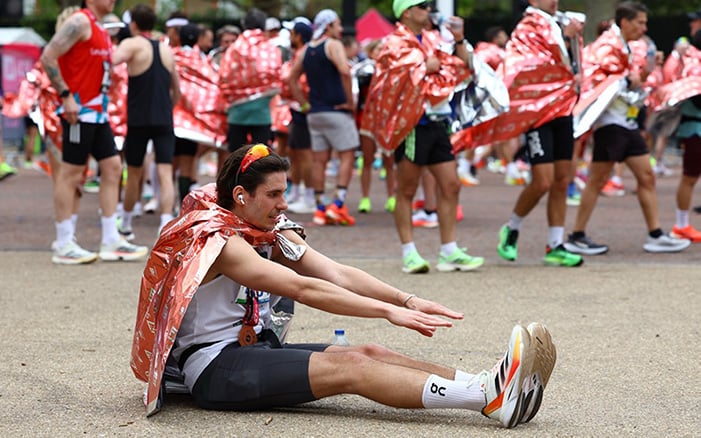Running your first marathon is a huge milestone. You’ve trained for months, logged the miles, nailed your long runs, and pictured the finish line more times than you can count. But even with all that prep, there are still plenty of ways to derail your big day—and most have nothing to do with how fit you are.
From pacing errors to gear mishaps, these mistakes are entirely avoidable—if you know what to watch for. Here are 10 things that can ruin your first marathon—and what to do instead to finish strong and proud.
1. Blowing off your taper and training too hard
You’ve trained for so many weeks and feel you’re finally ready to crush your first marathon. And then the taper starts—and suddenly you’re convinced you’re losing fitness by the day. Spoiler: you’re not.
The taper period—typically the last two to three weeks before your race—is essential. It allows your body to recover from months of high mileage so you show up fresh and ready. But many first-timers panic and pile on last-minute workouts or try to “squeeze in” one more long run. Big mistake.
Overtraining during your taper can leave you tired, sore, and flat on race day.
Instead, trust the process. Cut mileage by 20–40% per week in the final two to three weeks and use the extra time to sleep, eat well, and prepare mentally.
Remember: you won’t lose fitness in a taper—you’ll lock it in.
2. Walking too much the day before
You pick up your bib, the expo’s amazing, the city’s exciting, and suddenly you’ve logged 20,000 steps the day before your marathon. Oops.
Excess walking—even if it’s easy-paced—can leave your legs unusually fatigued. Light sightseeing can leave your legs more tired than you realize.
Skip the tourist itinerary until after the race. Keep movement to a minimum and save your effort for the run that matters.
Related: 15 Things to Know if You’re Running a Big-City Marathon
3. Showing up without a race-day plan
Your training plan was structured. Now you need a marathon-day strategy. Without it, it’s easy to get overwhelmed, make poor decisions, or burn energy on things that could’ve been sorted out ahead of time.
Here’s what to have in place before race morning:
- Know the course: Review the route map. Pay attention to elevation changes, aid station locations, and any turns or loops that could affect your rhythm. If there’s a hill at mile 22, you want to know that ahead of time.
- Coordinate logistics: Where is the parking, bag drop, porta-potties? When does your race/wave start? Where will you meet your supporters post-race? These small decisions matter when you’re stressed before the start and exhausted after finish.
- Plan your gear and layers: Know what you’ll wear at the start, what you might discard, and whether you need access to warm clothes after the finish.
- Have a fueling and hydration schedule: Decide in advance what you’ll eat and drink, and when. Don’t rely on “I’ll figure it out when I’m out there.”
- Create mental cues for tough moments: Whether it’s a mantra, a music cue, or reminding yourself why you’re doing this, have something prepared for mile 20 when things start to unravel.
And even after that, expect the unexpected. No race goes perfectly. If you have to stop to fix a shoelace, or use a porta-potty mid-race, or slow down because of heat, it’s not the end of your day. Having a flexible mindset is part of the plan.
Most race-day stress comes from feeling rushed or uncertain. You can avoid that by thinking ahead. A few minutes of planning now can save you miles of frustration later.

4. Making last-minute changes because you’re nervous
Race nerves make you question everything—your shoes, your outfit, your breakfast. It’s tempting to tweak things “just in case.” Don’t.
You’ve trained your body for months with certain routines and changing them can backfire. When in doubt, repeat what worked in training.
5. Trying something new on race day
This deserves its own point because, well, everyone does it. A new gel handed out at mile 10? A drink you’ve never tried? A pacing strategy you read about yesterday? Hard pass.
Anything you haven’t tested in training is a gamble. Best-case scenario: it works okay. Worst-case: you’re doubled over with GI issues or bonking hard at mile 20.
Race day is not the time to be curious, it’s time to execute what you know works. Bring your own fuel and stay in your lane.
Follow the golden rule: nothing new on race day. If it hasn’t been tested on a long run, save it for your next race.
6. Wearing too much or too little
A bad outfit can wreck a race. Overdress, and you’ll overheat. Underdress, and you’ll freeze at the start. Forget lube or sunscreen, and you’ll regret it by mile 12.
Prepare for the conditions:
- Check the forecast and plan for how it’ll feel mid-race, not just at the start
- Dress for 15–20°F warmer than the air temp (you’ll heat up fast)
- Avoid cotton—go for sweat-wicking technical gear
- Cover your head with a cap or buff if it’s sunny or cold
- Lube up anywhere that might chafe (thighs, arms, nipples, feet)
When in doubt, go slightly cooler—you can always add throwaway layers.
7. Starting too fast (and lining up too far forward)
This one ruins more marathons than anything else. The crowd is buzzing, your legs feel great, and suddenly you’re running a minute per mile faster than planned.
Going out too fast is a rookie mistake that can come back hard in the second half. Your best bet: start slower than goal pace for the first 3–5 miles, then ease in.
Also, don’t line up at the very front unless you belong there. Starting with faster runners will tempt you to chase them. Find your corral, relax, and run your race.
8. Chasing a time goal no matter what
Having a time goal is great. Being stubborn about it when conditions change? Not so much.
If it’s hotter than expected, windier, hillier, or your legs just aren’t feeling it, it’s okay to shift your expectations mid-race. Pushing through at all costs can lead to bonking, walking, or even injury.
Have tiers of goals:
- A goal: if everything goes right
- B goal: realistic based on training
- C goal: just finish strong and upright
9. Forgetting to fuel during the race
Marathon success depends on energy management. First-time marathoners often assume they’ll just eat when they feel hungry or tired. That’s too late. Fueling is proactive, not reactive.
Your body can store enough glycogen to fuel roughly 90 minutes of running. After that, without a steady supply of carbs, your energy nosedives. This isn’t a gradual fade—it’s a sharp drop in pace, motivation, and coordination. It’s one of the main reasons runners hit “the wall.”
Related: At What Mile Do Most Runners Quit a Marathon?
Because digestion slows during hard effort, you want to give your body carbs in manageable amounts, early and often.
Here’s how to get it right:
- Start fueling early: Take your first gel or carb source around 30–45 minutes into the race. Don’t wait until you feel tired.
- Stick to a schedule: Aim to take in 30–60 grams of carbohydrates per hour. For most runners, that’s 1 gel every 30–40 minutes.
- Practice during training: Your stomach can adapt to mid-run fueling, but only if you give it the chance. Use long runs to test brands, textures, and timing.
- Alternate fuel types if needed: Some runners prefer to mix gels with chews or sports drinks. That’s fine, as long as your total carb intake stays consistent.
- Use aid stations wisely: If you’re relying on on-course nutrition, research what’s being offered. Don’t assume it’ll be the brand you trained with.
- Bring backups: Carry at least one extra gel beyond what you think you need—just in case you drop one, feel low, or miss an aid station.
- Wash down gels with water: Taking a gel without water can slow digestion or upset your stomach. Plan your intake around hydration points.
Missing even one scheduled fuel can catch up to you by mile 20. And once you bonk, it’s hard to recover.
Fueling is one of the most controllable parts of your race-day strategy—don’t leave it to chance.
10. Obsessing over GPS watch data
We get it—you love your splits. But mid-marathon is not the time to stare at your watch every quarter-mile. Glitches happen. Mile markers won’t match your screen. And pace data can fluctuate wildly in crowds or big cities.
Obsessing over pace splits can distract from how you’re actually feeling. Glance, but don’t fixate. Effort matters more than the number.
Read next: What Happens to Your Body During and After a Marathon?
These are all small things—but in a marathon, small things get big fast. Avoid these common traps, trust your training, and focus on enjoying the experience. You only get one first time—make it one to remember for the right reasons.











